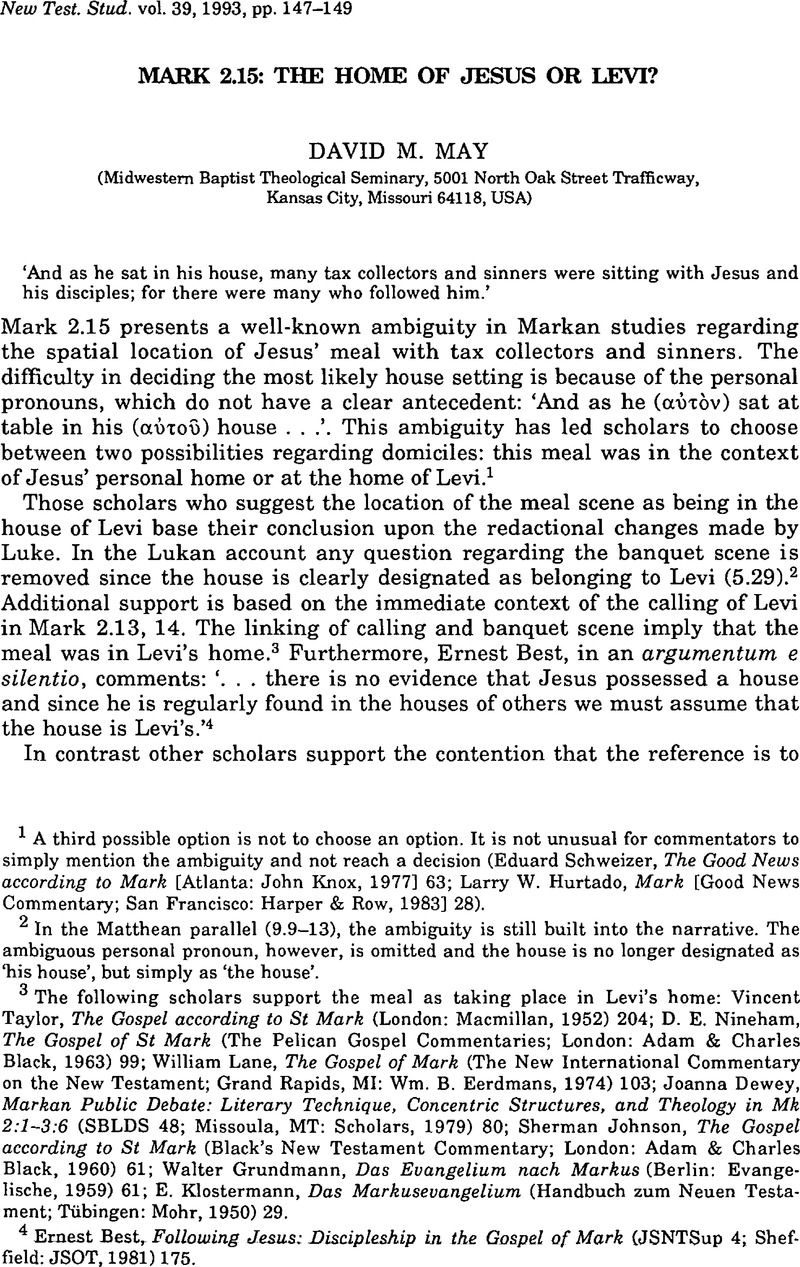Article contents
Mark 2.15: The Home of Jesus or Levi?
Published online by Cambridge University Press: 05 February 2009
Abstract

- Type
- Short Studies
- Information
- Copyright
- Copyright © Cambridge University Press 1993
References
1 A third possible option is not to choose an option. It is not unusual for commentators to simply mention the ambiguity and not reach a decision (Schweizer, Eduard, The Good News according to Mark [Atlanta: John Knox, 1977] 63Google Scholar; Hurtado, Larry W., Mark [Good News Commentary; San Francisco: Harper & Row, 1983] 28).Google Scholar
2 In the Matthean parallel (9.9–13), the ambiguity is still built into the narrative. The ambiguous personal pronoun, however, is omitted and the house is no longer designated as ‘his house’, but simply as ‘the house’.
3 The following scholars support the meal as taking place in Levi's home: Taylor, Vincent, The Gospel according to St Mark (London: Macmillan, 1952) 204Google Scholar; Nineham, D. E., The Gospel of St Mark (The Pelican Gospel Commentaries; London: Adam & Charles Black, 1963) 99Google Scholar; Lane, William, The Gospel of Mark (The New International Commentary on the New Testament; Grand Rapids, MI: Wm. B. Eerdmans, 1974) 103Google Scholar; Dewey, Joanna, Markan Public Debate: Literary Technique, Concentric Structures, and Theology in Mk 2:1–3:6 (SBLDS 48; Missoula, MT: Scholars, 1979) 80Google Scholar; Johnson, Sherman, The Gospel according to St Mark (Black's New Testament Commentary; London: Adam & Charles Black, 1960) 61Google Scholar; Grundmann, Walter, Das Evangelium nach Markus (Berlin: Evange-lische, 1959) 61Google Scholar; Klostermann, E., Das Markusevangelium (Handbuch zum Neuen Testament; Tübingen: Mohr, 1950) 29.Google Scholar
4 Best, Ernest, Following Jesus: Discipleship in the Gospel of Mark (JSNTSup 4; Sheffield: JSOT, 1981) 175.Google Scholar
5 For example, Ezra Gould, P., Gospel according to St Mark (The International Critical Commentary; Edinburgh: T. & T. Clark, 1896) 41Google Scholar; Holtzmann, H., Die Synoptiker (Hand-buch zum Neuen Testament; Tübingen: Mohr, 1901) 119–20Google Scholar; Meyer, E., Ursprung und Anfänge des Christentums (Stuttgart: J. G. Gotta, 1921)Google Scholar; Malbon, Elizabeth Struthers, ‘TH OIKIA AYTOY: Mark 2.15 in Context’, NTS 31 (1985) 282–92CrossRefGoogle Scholar. Malbon's view is gaining followers: Stock, Augustine, The Method and Message of Mark (Wilmington, DE: Michael Glazier, 1989) 103–4.Google Scholar
6 Malbon, 282–3.
7 Ibid., 284.
8 Ibid., 288.
9 Malina, Bruce, The New Testament World: Insights from Cultural Anthropology (Atlanta: John Knox, 1981) 51–70.Google Scholar Malina draws upon the work of anthropologist Foster, George, ‘Peasant Society and the Image of Limited Good’, American Anthropologist 67 (1965) 293–315.CrossRefGoogle Scholar
10 The implied contract between those of superior and inferior social status is a patron-client relationship. See Elliott, John, ‘Patronage and Clientism in Early Christian Society: A Short Reading Guide’, Forum 3 (1987) 39–48Google Scholar; Malina, Bruce, ‘Patron and Client: The Analogy Behind Synoptic Theology’, Forum 4 (1988) 2–32.Google Scholar
11 Malina, World, 80.
12 Ibid.
13 The collegial dyadic relationship is continued in the brief account of Jesus' healing of Peter's mother-in-law. Since Jesus accepted the invitation into Peter and Andrew's home, they want him to reciprocate by healing the mother-in-law.
14 Malina, World, 80.
15 Malbon, 283.
- 1
- Cited by




